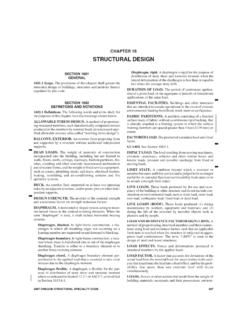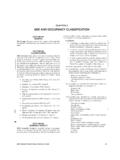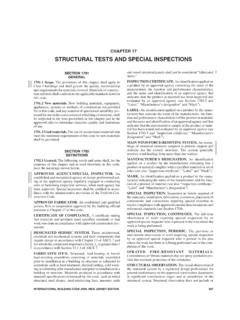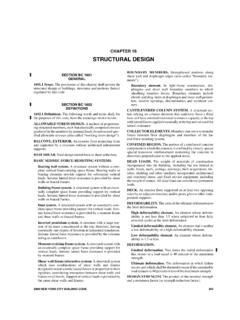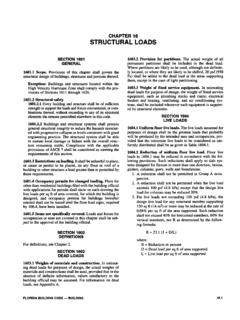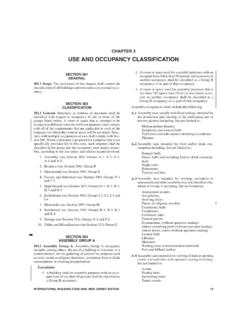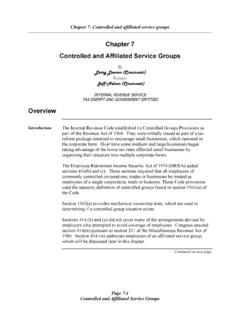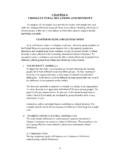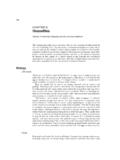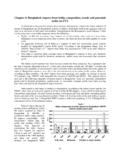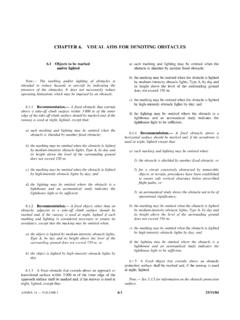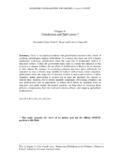Transcription of CHAPTER 3 USE AND OCCUPANCY CLASSIFICATION
1 CHAPTER 3 USE AND OCCUPANCY CLASSIFICATIONSECTION provisions of this CHAPTER shall control theclassification of all buildings and structures as to use and or portions of structures shall beclassified with respect to OCCUPANCY in one or more of thegroups listed below. A room or space that is intended to beoccupied at different times for different purposes shall com-ply with all of the requirements that are applicable to each ofthe purposes for which the room or space will be with multiple occupancies or uses shall complywith Section 508. Where a structure is proposed for a purposethat is not specifically provided for in this code, such structureshall be classified in the group that the OCCUPANCY most nearlyresembles, according to the fire safety and relative Assembly (see Section 303): Groups A-1, A-2, A-3,A-4 and A-52. Business (see Section 304): Group B3. Educational (see Section 305): Group E4. Factory and Industrial (see Section 306): Groups F-1and F-25.
2 High Hazard (see Section 307): Groups H-1, H-2, H-3,H-4 and H-56. Institutional (see Section 308): Groups I-1, I-2, I-3 andI-47. Mercantile (see Section 309): Group M8. Residential (see Section 310): Groups R-1, R-2, R-3and R-49. Special residence for assisted self-preservation (seeAppendix SR): Groups SR-1, SR-2, SR-3 and SR-410. Storage (see Section 311): Groups S-1 and S-211. Utility and Miscellaneous (see Section 312): Group USECTION 303 ASSEMBLY GROUP Assembly Group Group A occupancyincludes, among others, the use of a building or structure, or aportion thereof, for the gathering of persons for purposes suchas civic, social or religious functions; recreation, food or drinkconsumption; or awaiting :1. A building or tenant space used for assembly pur-poses with an occupant load of less than 50 personsshall be classified as a Group B A room or space used for assembly purposes with anoccupant load of less than 50 persons and accessory toanother OCCUPANCY shall be classified as a Group Boccupancy or as part of that A room or space used for assembly purposes that isless than 750 square feet (70 m2) in area and is acces-sory to another OCCUPANCY shall be classified as aGroup B OCCUPANCY or as part of that occupancies shall include the following:A-1 Assembly uses, usually with fixed seating, intended forthe production and viewing of the performing arts ormotion pictures including, but not limited to:Motion picture theatersSymphony and concert hallsTelevision and radio studios admitting an audienceTheatersA-2 Assembly uses intended for food and/or drink con-sumption including, but not limited to.
3 Banquet hallsNight clubsRestaurantsTaverns and barsA-3 Assembly uses intended for worship, recreation oramusement and other assembly uses not classified else-where in Group A including, but not limited to:Amusement arcadesArt galleriesBowling alleysPlaces of religious worshipCommunity hallsCourtroomsDance halls (not including food or drink consump-tion)Exhibition hallsFuneral parlorsGymnasiums (without spectator seating)Indoor swimming pools (without spectator seating)Indoor tennis courts (without spectator seating)Lecture hallsLibrariesMuseums2007 OREGON STRUCTURAL SPECIALTY CODE25 :\data\CODES\STATE CODES\Oregon\2007\Structural Specialty\Final VP_Chgo\ , January 10, 2007 1:45:51 PMColor profile: Generic CMYK printer profileComposite Default screenWaiting areas in transportation terminalsPool and billiard parlorsA-4 Assembly uses intended for viewing of indoor sportingevents and activities with spectator seating including,but not limited to:ArenasSkating rinksSwimming poolsTennis courtsA-5 Assembly uses intended for participation in or viewingoutdoor activities including, but not limited to:Amusement park structuresBleachersGrandstandsStadiumsSE CTION 304 BUSINESS GROUP Business Group Group B occupancyincludes, among others, the use of a building or structure, or aportion thereof, for office, professional or service-type transac-tions, including storage of records and accounts.
4 Businessoccupancies shall include, but not be limited to, the following:Airport traffic control towersAnimal hospitals, kennels and poundsBanksBarber and beauty shopsCar washCivic administrationClinic outpatient (see definition in Section )Dry cleaning and laundries: pick-up and delivery stationsand self-serviceEducational occupancies for students above the 12th gradeElectronic data processingLaboratories: testing and researchMotor vehicle showroomsPost officesPrint shopsProfessional services (architects, attorneys, dentists,physicians, engineers, etc.)Radio and television stationsTelephone exchangesTraining and skill development not within a school oracademic following words and terms shall,for the purposes of this section and as used elsewhere in thiscode, have the meanings shown medical office or facilityserving patients who are capable of self-preservation, ornot more than five patients who may be incapable ofself-preservation (for facilities with more than fivepatients who may be incapable of self-preservation, seeAmbulatory Health Care Facilities in Section ).
5 Lockup containing lockup facili-ties, as defined in ORS (4), shall comply with the fol-lowing provisions:1. Areas containing lockup facilities shall be separatedfrom other rooms, spaces or areas by an approved smokebarrier (see Section ).2. The smoke control zone in which the lockup cells arelocated shall be provided with an automatic fire sprinklersystem complying with CHAPTER 9 requirements forGroup I-3 The smoke control zone in which the lockup area islocated shall be provided with an automatic smokedetection system installed in accordance with theFireCodeGroup I-3 The combined occupant load of the holding cells shallnot exceed OREGON STRUCTURAL SPECIALTY CODEUSE AND OCCUPANCY CLASSIFICATIONORS not part of this code but is reproduced here for thereader s Inspections; approval of plans and specifications;rules; fees.(1) The Department of Human Services shall make or cause to bemade such inspections as it may deem necessary.
6 (2) The Department of Human Services may prescribe by rule that anylicensee or prospective applicant desiring to make specified types ofalteration or addition to its facilities or to construct new facilities shall,before commencing such alteration, addition or new construction,either prior to or after receiving a certificate of need pursuant to (1987 Replacement Part), if required, submit plans and speci-fications therefor to the department for preliminary inspection andapproval or recommendations with respect to compliance with therules authorized by ORS and and for compliancewith National Fire Protection Association standards when the facilityis also to be Medicare or Medicaid certified. The department mayrequire by rule payment of a fee for project review services at a vari-able rate, dependent on total project cost. For health care facilities, thedepartment shall develop a review fee schedule as minimally neces-sary to support the staffing level and expenses required to administerthe program.
7 The fee for project review of residential care facilitiesshall equal two-thirds that required of health care facilities. Thedepartment may also conduct an on-site review of projects as a prereq-uisite to licensure of new facilities, major renovations and department shall, at least annually, with the advice of facili-ties covered by this review, present proposed rule changes regard-ing facility design and construction to such agencies for theirconsideration. The department shall also publish a state submis-sions guide for health and residential care facility projects andadvise project sponsors of applicable requirements of federal, stateand local regulatory agencies. [Amended by 1965 2; 14; 1973 10; 1985 29; 1987 11; 23; 2001 178; 2001 169]ORS (5)is not part of this code but is reproduced here forthe reader s (5) Lockup means a facility for the temporary detentionof arrested persons held for up to 36 hours, excluding holidays,Saturdays and Sundays, but the period in lockup shall not exceed96 hours after :\data\CODES\STATE CODES\Oregon\2007\Structural Specialty\Final VP_Chgo\ , January 10, 2007 1:45:51 PMColor profile: Generic CMYK printer profileComposite Default screenSECTION 305 EDUCATIONAL GROUP Educational Group Group E occupancyincludes, among others, the use of a building or structure, or aportion thereof, by six or more persons at any one time for edu-cational purposes through the 12th grade.
8 Religious educa-tional rooms and religious auditoriums, which are accessory toplaces of religious worship in accordance with Section have occupant loads of less than 100, shall be classified asA-3 Day use of a building or structure, or portionthereof, for educational, supervision or personal care servicesfor more than five children older than 21/2years of age, shall beclassified as a Group E 306 FACTORY GROUP Factory Industrial Group Industrial GroupF OCCUPANCY includes, among others, the use of a building orstructure, or a portion thereof, for assembling, disassembling,fabricating, finishing, manufacturing, packaging, repair or pro-cessing operations that are not classified as a Group H hazard-ous or Group S storage Factory Industrial F-1 Moderate-hazard industrial uses which are not classified as FactoryIndustrial F-2 Low Hazard shall be classified as F-1 ModerateHazard and shall include, but not be limited to, the following:AircraftAppliancesAthletic equipmentAutomobiles and other motor vehiclesBakeriesBeverages; over 16-percent alcohol contentBicyclesBoatsBrooms or brushesBusiness machinesCameras and photo equipmentCanvas or similar fabricCarpets and rugs (includes cleaning)ClothingConstruction and agricultural machineryDisinfectantsDry cleaning and dyeingElectric generation plantsElectronicsEngines (including rebuilding)Food processingFurnitureHemp productsJute productsLaundriesLeather productsMachineryMetalsMillwork (sash & door)Motion pictures and television filming (without spectators)Musical instrumentsOptical goodsPaper mills or productsPhotographic filmPlastic productsPrinting or publishingRecreational vehiclesRefuse incinerationShoesSoaps and detergentsTextilesTobaccoTrailersUpholst eringWood.
9 DistillationWoodworking (cabinet) Factory Industrial F-2 Low-hazard industrial uses that involve the fabrication or manufactur-ing of noncombustible materials which during finishing,packing or processing do not involve a significant fire hazardshall be classified as F-2 occupancies and shall include, but notbe limited to, the following:Beverages; up to and including 16-percent alcohol contentBrick and masonryCeramic productsFoundriesGlass productsGypsumIceMetal products (fabrication and assembly)Wood barrel and bottled wine aging facilities in wineriesSECTION 307 HIGH-HAZARD GROUP H[F] High-hazard Group Group H occu-pancy includes, among others, the use of a building or struc-ture, or a portion thereof, that involves the manufacturing,processing, generation or storage of materials that constitute aphysical or health hazard in quantities in excess of thoseallowed in control areas constructed and located as required inSection 414.
10 Hazardous uses are classified in Groups H-1, H-2,H-3, H-4 and H-5 and shall be in accordance with this section,the requirements of Section 415 and theFire :The following shall not be classified in GroupH, but shall be classified in the OCCUPANCY that they mostnearly resemble:1. Buildings and structures that contain not more thanthe maximum allowable quantities per control areaof hazardous materials as shown in Tables (1)and (2), provided that such buildings are main-tained in accordance with theFire Buildings utilizing control areas in accordance withSection that contain not more than the maxi-mum allowable quantities per control area of haz-ardous materials as shown in Tables (1) (2).3. Buildings and structures occupied for the applica-tion of flammable finishes, provided that such build-2007 OREGON STRUCTURAL SPECIALTY CODE27 USE AND OCCUPANCY :\data\CODES\STATE CODES\Oregon\2007\Structural Specialty\Final VP_Chgo\ , January 10, 2007 1:45:52 PMColor profile.
